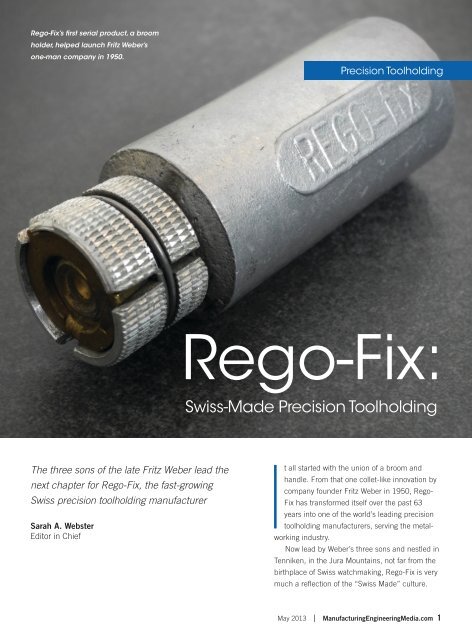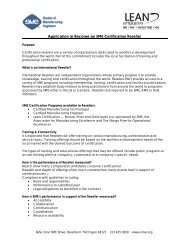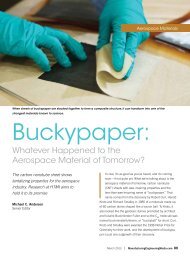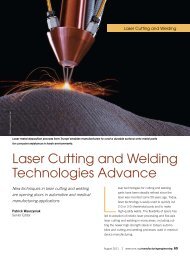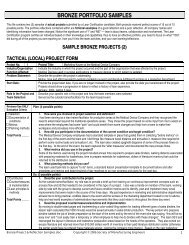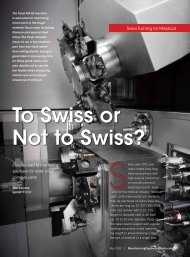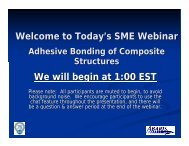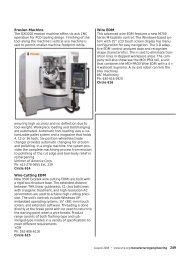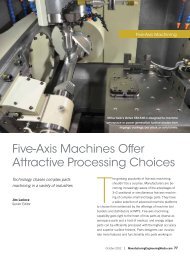Click here for PDF - Society of Manufacturing Engineers
Click here for PDF - Society of Manufacturing Engineers
Click here for PDF - Society of Manufacturing Engineers
You also want an ePaper? Increase the reach of your titles
YUMPU automatically turns print PDFs into web optimized ePapers that Google loves.
Rego-Fix’s first serial product, a broom<br />
holder, helped launch Fritz Weber’s<br />
one-man company in 1950.<br />
Precision Toolholding<br />
Rego-Fix:<br />
Swiss-Made Precision Toolholding<br />
The three sons <strong>of</strong> the late Fritz Weber lead the<br />
next chapter <strong>for</strong> Rego-Fix, the fast-growing<br />
Swiss precision toolholding manufacturer<br />
Sarah A. Webster<br />
Editor in Chief<br />
It all started with the union <strong>of</strong> a broom and<br />
handle. From that one collet-like innovation by<br />
company founder Fritz Weber in 1950, Rego-<br />
Fix has trans<strong>for</strong>med itself over the past 63<br />
years into one <strong>of</strong> the world’s leading precision<br />
toolholding manufacturers, serving the metalworking<br />
industry.<br />
Now lead by Weber’s three sons and nestled in<br />
Tenniken, in the Jura Mountains, not far from the<br />
birthplace <strong>of</strong> Swiss watchmaking, Rego-Fix is very<br />
much a reflection <strong>of</strong> the “Swiss Made” culture.<br />
May 2013 | <strong>Manufacturing</strong>EngineeringMedia.com 1
Precision Toolholding<br />
For ages, that label that has stood <strong>for</strong> quality and precision,<br />
because it was made in Switzerland. How and why did<br />
the Swiss become world-renowned masters <strong>of</strong> precision?<br />
From left to right, Andreas Weber, Rego-Fix Tool Corp., President;<br />
Stefan Weber, Rego-Fix AG, VP Marketing/Product Development;<br />
and Richard Weber, Rego-Fix AG, President/CEO.<br />
Switzerland is a small, landlocked country, a little bit bigger<br />
than the state <strong>of</strong> Maryland, bordered by Germany, Austria, Italy<br />
and France. Perhaps its reputation <strong>for</strong> precision has something<br />
to do with the Alps, which had to be contended with and<br />
conquered. T<strong>here</strong> seems to be little room <strong>for</strong> error in building<br />
tunnels through those dangerously grand mountains or laying<br />
narrow railways along their steep, avalanche-prone faces.<br />
“When the economy was good,<br />
we were always a little behind,”<br />
Richard said <strong>of</strong> production.<br />
Culturally, the Swiss embrace precision in virtually all<br />
aspects in life. They are a punctual, clean, thrifty and orderly,<br />
logical, lot.<br />
Rego-Fix is no different.<br />
A History <strong>of</strong> Innovation<br />
Fritz Weber (1924–2008) came from a large, poor Swiss<br />
family and was known around town as an idea man. His<br />
original innovation, to connect a broom to a handle, was a<br />
metal collet-like innovation that quickly found supporters. The<br />
product was considered successful enough to launch the oneman<br />
company Fritz Weber Feinmechanik und Werkzeugbau<br />
in Reigoldswil in 1950.<br />
Within seven years, the company grew to 15 employees<br />
at Rego-Fix’s tight headquarters, which also served as the<br />
Weber home, tucked into the hillside in the Swiss canton <strong>of</strong><br />
Basel-Country.<br />
“I was born almost in the factory,” Richard Weber, now<br />
CEO <strong>of</strong> Rego-Fix, joked.<br />
Several phases <strong>of</strong> expansion followed, eventually leaving<br />
Rego-Fix with little space to grow.<br />
That was especially true after Rego-Fix’s revolutionary<br />
product launched in 1972—the patented ER collet chuck.<br />
Prior to that invention, machinists using collet chucks <strong>of</strong>ten<br />
slammed a hammer onto their machine to knock their collet<br />
chuck loose.<br />
Weber developed a slight shoulder around the circumference<br />
<strong>of</strong> the collet check that allowed <strong>for</strong> easy removal, a<br />
simple and elegant solution to a routine problem—and one<br />
that would <strong>for</strong>ever change the future <strong>for</strong> Rego-Fix.<br />
Growth was fast after that innovation, leaving Rego-Fix in<br />
an almost perpetual race to keep up with demand.<br />
In 1980, the company went public and changed its<br />
name and trademark to Rego-Fix, a spin <strong>of</strong>f the town <strong>of</strong><br />
Reigoldswil, w<strong>here</strong> the company was originally founded.<br />
In 1982, Rego-Fix acquired another production building<br />
in Switzerland.<br />
Richard Weber fondly recalls his late father returning<br />
home from his first trip to the US and excitedly declaring:<br />
“They need thousands and millions <strong>of</strong> collets!” In 1988, the<br />
US subsidiary, Rego-Fix Tool Corp., was established.<br />
By 1998, the company was out <strong>of</strong> room at its original<br />
location and moved about 12 miles away to Tenniken, w<strong>here</strong><br />
it made major investments to modernize, including a major<br />
expansion <strong>of</strong> its facilities in 2012.<br />
The Weber sons made sure to include ample space <strong>for</strong><br />
future growth. “When the economy was good, we were always<br />
a little behind,” Richard said <strong>of</strong> production.<br />
A Demonstration <strong>of</strong> Advanced <strong>Manufacturing</strong><br />
The new Rego-Fix headquarters embraces advanced<br />
manufacturing.<br />
Apart from being super clean, it is environmentally<br />
friendly and highly automated. It has a green ro<strong>of</strong> that<br />
2 <strong>Manufacturing</strong>EngineeringMedia.com | May 2013
1950: Fritz Weber establishes the one-man company<br />
Fritz Weber Feinmechanik und Werkzeugbau in Reigoldswil,<br />
in Swiss Jura.<br />
Rego-Fix Timeline<br />
1957: The company is growing and now has 15 employees.<br />
A new production building is constructed.<br />
1962–1968: The company expands further. The production<br />
building is extended twice within a period <strong>of</strong> six years.<br />
1972: The ER collet chuck is developed and patented.<br />
Patent drawing <strong>of</strong> the original ER collet chuck.<br />
1980: The company is trans<strong>for</strong>med into a public limited<br />
company and the trademark Rego-Fix ® becomes the<br />
company name.<br />
1982: An additional production building is acquired.<br />
1988: In the USA the subsidiary company Rego-Fix Tool<br />
Corp. is established.<br />
1990: Rego-Fix AG procures a 50% share <strong>of</strong> Ramseyer SA,<br />
Le Landeron.<br />
1991: The turning and milling shops are relocated to a<br />
modern building and the existing buildings renovated.<br />
1993: The ER collet chuck is standardised with<br />
DIN 6499.<br />
1994: Rego-Fix GmbH is established in Germany.<br />
1995: The quality certificate is acquired per ISO 9001.<br />
1998: Production and <strong>of</strong>fices in Reigoldswil and Liestal are<br />
combined at today’s head <strong>of</strong>fice in Tenniken.<br />
1999: Rego-Fix undertakes major capital investment in new<br />
processing centres. Rego-Fix Tool Corp. relocates to a new,<br />
larger building in Indianapolis.<br />
2000: Rego-Fix celebrates its 50-year anniversary.<br />
Fritz Weber (1924-2008) established REGO-FIX in 1950.<br />
2002: powRgrip is introduced. The system is<br />
groundbreaking because it enables the fastest possible<br />
clamping (< 10 sec) at the touch <strong>of</strong> a button and <strong>of</strong>fers<br />
the best in concentricity, high clamping <strong>for</strong>ce and<br />
vibration damping.<br />
2006: The company enters its second generation. The sons<br />
<strong>of</strong> company founder Fritz Weber take over the Rego-Fix<br />
group and establish Rego Holding AG.<br />
2007: The powRgrip portfolio is expanded to include the PG<br />
32. Clamping ranges <strong>of</strong> up to 25.4 mm are now possible.The<br />
Rego-Fix (Shanghai) Rep. Office, China is established.The<br />
Rego-Fix CAPTO toolholder is introduced.<br />
2010: Rego Plus holders are produced.<br />
2012: Following a building extension, more than double the<br />
production and storage space is now available. Automation is<br />
significantly expanded. The powRgrip portfolio is extended to<br />
include size PG 6, specifically <strong>for</strong> micro machining.<br />
May 2013 | <strong>Manufacturing</strong>EngineeringMedia.com 3
Precision Toolholding<br />
collects rainwater to flush toilets, the air<br />
circulates seven times per hour, the company<br />
burns wood pellets <strong>for</strong> heat and it has a<br />
growing family <strong>of</strong> Kuka and Staubli robots. In<br />
fact, the company added 10 Kuka robots in<br />
the past year.<br />
“That’s why we can stay in Switzerland,”<br />
Richard Weber said.<br />
Be<strong>for</strong>e the company embarked on its<br />
most recent and extensive expansion, in the<br />
midst <strong>of</strong> the Great Recession, the Weber<br />
sons had to really weigh the pros and cons<br />
<strong>of</strong> keeping production in their home country.<br />
Labor and virtually all other costs are extremely<br />
high in Switzerland relative to the rest<br />
<strong>of</strong> the world, largely because <strong>of</strong> the high value<br />
<strong>of</strong> the Swiss franc (the long-netural country<br />
The company embarked on an extensive expansion in 2009 that<br />
passed on joining the EU).<br />
was completed in 2012, giving Rego-Fix ample new space <strong>for</strong> future<br />
For that reason, and despite producing<br />
expansion after years <strong>of</strong> struggling to keep up with demand.<br />
about half <strong>of</strong> the world’s watches, Switzerland<br />
is not not known <strong>for</strong> being a production country per factors, has become a high-output production company,<br />
se. But Rego-Fix, with the help <strong>of</strong> automation and other running three shifts, 24 hours a day to keep up with demand<br />
<strong>for</strong> its products.<br />
Aside from the automation, Switzerland’s highly skilled<br />
work<strong>for</strong>ce also allows the firm to keep production in its home<br />
country. A scan around the production floor shows workers<br />
<strong>of</strong> all ages and both sexes, a very different landscape than<br />
the production floor in, say, a US factory which tends to be<br />
male and greying.<br />
“That’s why we can stay in Switzerland,”<br />
Richard Weber said <strong>of</strong> all the<br />
company’s new automation.<br />
Rego-Fix President and CEO Richard Weber reflects <strong>for</strong> a<br />
moment at the company’s newly expanded headquarters<br />
in Tenniken. In the <strong>for</strong>eground, an old collet chuck next to<br />
an ER Collet Chuck, the company’s groundbreaking product<br />
launched in 1972.<br />
While the US and many other countries battle a shortage<br />
<strong>of</strong> workers skilled in STEM (science, technology, engineering<br />
and math) fields, “the skill level is high” in Switzerland,<br />
Richard Weber said. Which is necessary, since each employee<br />
oversees three highly productive machines.<br />
What’s more, t<strong>here</strong>’s a high level <strong>of</strong> institutional knowledge<br />
at Rego-Fix. The company has an impressive number <strong>of</strong> workers<br />
who’ve been t<strong>here</strong> <strong>for</strong> 40 years.<br />
“That is typical,” Richard Weber said. “Most employees<br />
are with us <strong>for</strong> a long time.”<br />
4 <strong>Manufacturing</strong>EngineeringMedia.com | May 2013
Another asset is simply what he called the “very good<br />
support system” <strong>for</strong> precision manufacturing in Switzerland.<br />
all in the same holder. The PG system consists <strong>of</strong> a toolholder,<br />
high-precision collet, and a compact bench-top hydraulic<br />
press to insert the collet into the holder.<br />
The specially designed collets are inserted with up to nine<br />
tons <strong>of</strong> <strong>for</strong>ce, creating gripping strengths higher than shrink fit<br />
without the small tool and cutter type limitations <strong>of</strong> using hightemperature<br />
shrink systems. Tool changes take just seconds,<br />
instead <strong>of</strong> minutes.<br />
“We three brothers view this as<br />
a responsibility to our family and<br />
employees,” Richard Weber explains.<br />
In 2012, the powRgrip portfolio was extended to include<br />
size PG 6, specifically <strong>for</strong> micro machining. It is aimed at the<br />
aerospace and medical industries.<br />
Introduced in 2002, powRgrip uses a press-fit technology to<br />
change tools in seconds with high accuracy, high clamping<br />
<strong>for</strong>ce and without heat.<br />
“Everything is closer in Switzerland,” Richard Weber explained,<br />
including, <strong>for</strong> example, the company that heat-treats<br />
all <strong>of</strong> Rego-Fix’s product line.<br />
A Full House <strong>of</strong> Products<br />
Rego-Fix <strong>of</strong>fers a full range <strong>of</strong> collets, tapping collets, holders<br />
with nuts, wrenches and other products.<br />
But its most popular introduction in recent years has been<br />
the powRgrip line, which allows <strong>for</strong> tool changes without heat<br />
or hydraulics.<br />
Introduced in 2002, the powRgrip system is a mechanical<br />
clamping system that generates the highest clamping <strong>for</strong>ces,<br />
unbeatable run-out, and the ability to use different size tools<br />
A Future <strong>of</strong> Ideas<br />
One <strong>of</strong> the key challenges facing the Weber sons and the<br />
Rego-Fix they aim to lead into the future is keeping innovation<br />
alive without their father at the helm.<br />
“We three brothers view this as a responsibility to our family<br />
and employees,” Richard Weber explains.<br />
While Richard Weber runs the global business operations<br />
and Andreas Weber, President <strong>of</strong> Rego-Fix Tool<br />
Corp., runs sales out <strong>of</strong> the North American <strong>of</strong>fice in Indianapolis,<br />
IN, Stefan Weber, Vice President <strong>of</strong> Marketing and<br />
Product Development, seems to have inherited his father’s<br />
idea gene.<br />
“You can’t learn innovation,” Richard Weber said. “It’s<br />
really a gift … Stefan is the innovator. He’s always had<br />
good ideas.”<br />
VIDEO<br />
To learn more about powRgrip,<br />
visit http://www.Rego-Fix.com/video/)<br />
Stefan, however, said it’s much more <strong>of</strong> a team ef<strong>for</strong>t in<br />
the end. He has 12 fellow engineers who work in Rego-Fix’s<br />
research and development unit.<br />
“We need to bring out new stuff, and if possible, to protect<br />
it with a patent,” Stefan Weber said.<br />
In an honor to his father’s legacy, he added: “We have so<br />
many good ideas.” ME<br />
May 2013 | <strong>Manufacturing</strong>EngineeringMedia.com 5


